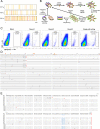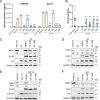Dominant Negative Mutants of Human Immunodeficiency Virus Type 1 Viral Infectivity Factor (Vif) Disrupt Core-Binding Factor Beta-Vif Interaction
- PMID: 35950859
- PMCID: PMC9472641
- DOI: 10.1128/jvi.00555-22
Dominant Negative Mutants of Human Immunodeficiency Virus Type 1 Viral Infectivity Factor (Vif) Disrupt Core-Binding Factor Beta-Vif Interaction
Abstract
Apolipoprotein B mRNA-editing catalytic polypeptide-like 3 family members (APOBEC3s) are host restriction factors that inhibit viral replication. Viral infectivity factor (Vif), a human immunodeficiency virus type 1 (HIV-1) accessory protein, mediates the degradation of APOBEC3s by forming the Vif-E3 complex, in which core-binding factor beta (CBFβ) is an essential molecular chaperone. Here, we screened nonfunctional Vif mutants with high affinity for CBFβ to inhibit HIV-1 in a dominant negative manner. We applied the yeast surface display technology to express Vif random mutant libraries, and mutants showing high CBFβ affinity were screened using flow cytometry. Most of the screened Vif mutants containing random mutations of different frequencies were able to rescue APOBEC3G (A3G). In the subsequent screening, three of the mutants restricted HIV-1, recovered G-to-A hypermutation, and rescued APOBEC3s. Among them, Vif-6M showed a cross-protection effect toward APOBEC3C, APOBEC3F, and African green monkey A3G. Stable expression of Vif-6M in T lymphocytes inhibited the viral replication in newly HIV-1-infected cells and the chronically infected cell line H9/HXB2. Furthermore, the expression of Vif-6M provided a survival advantage to T lymphocytes infected with HIV-1. These results suggest that dominant negative Vif mutants acting on the Vif-CBFβ target potently restrict HIV-1. IMPORTANCE Antiviral therapy cannot eliminate HIV and exhibits disadvantages such as drug resistance and toxicity. Therefore, novel strategies for inhibiting viral replication in patients with HIV are urgently needed. APOBEC3s in host cells are able to inhibit viral replication but are antagonized by HIV-1 Vif-mediated degradation. Therefore, we screened nonfunctional Vif mutants with high affinity for CBFβ to compete with the wild-type Vif (wtVif) as a potential strategy to assist with HIV-1 treatment. Most screened mutants rescued the expression of A3G in the presence of wtVif, especially Vif-6M, which could protect various APOBEC3s and improve the incorporation of A3G into HIV-1 particles. Transduction of Vif-6M into T lymphocytes inhibited the replication of the newly infected virus and the chronically infected virus. These data suggest that Vif mutants targeting the Vif-CBFβ interaction may be promising in the development of a new AIDS therapeutic strategy.
Keywords: apolipoprotein B mRNA-editing catalytic polypeptide-like 3 family member (APOBEC3); core-binding factor beta (CBFβ); dominant negative mutant; human immunodeficiency virus (HIV); viral infectivity factor (Vif).
Conflict of interest statement
The authors declare no conflict of interest.
Figures






Similar articles
-
A novel HIV-1 inhibitor that blocks viral replication and rescues APOBEC3s by interrupting vif/CBFβ interaction.J Biol Chem. 2020 Oct 23;295(43):14592-14605. doi: 10.1074/jbc.RA120.013404. Epub 2020 Aug 19. J Biol Chem. 2020. PMID: 32817167 Free PMC article.
-
Inhibition of Vif-Mediated Degradation of APOBEC3G through Competitive Binding of Core-Binding Factor Beta.J Virol. 2020 Mar 17;94(7):e01708-19. doi: 10.1128/JVI.01708-19. Print 2020 Mar 17. J Virol. 2020. PMID: 31941780 Free PMC article.
-
Core binding factor beta plays a critical role by facilitating the assembly of the Vif-cullin 5 E3 ubiquitin ligase.J Virol. 2014 Mar;88(6):3309-19. doi: 10.1128/JVI.03824-13. Epub 2014 Jan 3. J Virol. 2014. PMID: 24390320 Free PMC article.
-
HIV-1 Vif, APOBEC, and intrinsic immunity.Retrovirology. 2008 Jun 24;5:51. doi: 10.1186/1742-4690-5-51. Retrovirology. 2008. PMID: 18577210 Free PMC article. Review.
-
Degradation-Independent Inhibition of APOBEC3G by the HIV-1 Vif Protein.Viruses. 2021 Apr 3;13(4):617. doi: 10.3390/v13040617. Viruses. 2021. PMID: 33916704 Free PMC article. Review.
Cited by
-
Functional variability of Nef in antagonizing SERINC5 during acute to chronic HIV-1 infection.AIDS. 2025 Mar 1;39(3):229-240. doi: 10.1097/QAD.0000000000004079. Epub 2024 Dec 4. AIDS. 2025. PMID: 39612239 Free PMC article.
-
The unique structure of the highly conserved PPLP region in HIV-1 Vif is critical for the formation of APOBEC3 recognition interfaces.mBio. 2025 Mar 12;16(3):e0333224. doi: 10.1128/mbio.03332-24. Epub 2025 Jan 21. mBio. 2025. PMID: 39835817 Free PMC article.
-
Design of Vif-Derived Peptide Inhibitors with Anti-HIV-1 Activity by Interrupting Vif-CBFβ Interaction.Viruses. 2024 Mar 22;16(4):490. doi: 10.3390/v16040490. Viruses. 2024. PMID: 38675833 Free PMC article.
References
Publication types
MeSH terms
Substances
LinkOut - more resources
Full Text Sources
Medical

